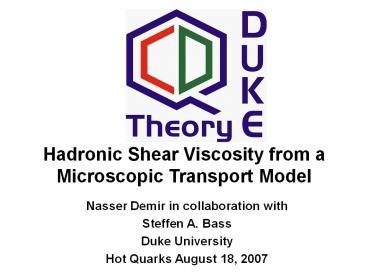Hadronic Shear Viscosity from a Microscopic Transport Model - PowerPoint PPT Presentation
Title:
Hadronic Shear Viscosity from a Microscopic Transport Model
Description:
Motivation: 'Low Viscosity Matter' at RHIC & Consequences. Theory: Kubo Formalism for Transport Coefficients ... Pyx. Vx= v1. Vx= v2. Shear Viscosity Coefficient: ... – PowerPoint PPT presentation
Number of Views:83
Avg rating:3.0/5.0
Title: Hadronic Shear Viscosity from a Microscopic Transport Model
1
Hadronic Shear Viscosity from a Microscopic
Transport Model
Nasser Demir in collaboration with Steffen A.
Bass Duke University Hot Quarks August 18, 2007
2
Overview
- Motivation Low Viscosity Matter at RHIC
Consequences - Theory Kubo Formalism for Transport Coefficients
- Analysis/Results Chemical Potentials, Results
for Viscosity - Summary/Outlook
3
Low Viscosity Matter at RHIC
large viscosity
QGP and hydrodynamic expansion
initial state
freeze-out
low viscosity
pre-equilibrium
hadronic phase
- Why study hadronic phase?
- Need to know hadronic
- viscosity to constrain QGP
- viscosity.
- Viscosity changes as function
- of time in a heavy ion collision!
- 3) Viscous hydro calculations assume fixed ?/s
throughout entire evolution (need low ?/s)
QGP-like phase at RHIC observed to behave
very much like ideal fluid ideal hydro treatment
of QGP phase works well but what about
hadronic phase?
4
Question re low viscosity
- How low is it? (AdS/CFT ?/s1/4p? KSS bound)
PRL 94. 111601 (2005) Kovtun, Son, Starinets
NOTE Hadronic phase of HIC not a chiral pion
gas, nor a binary pion-kaon mixture!
Viscous hydro needs ?/s(2-3)/4p !
Csernai, Kapusta, McLerran nucl-th/0604032 PRL
97. 152303 (2006)
Luzum, Romatschke arXiv0804.4015 nucl-th
Pert. Theory N/A here.
5
What do we know thus far?
- Determining hadronic viscosity necessary to
constrain viscosity of QGP. - Perturbative methods not well trusted near
- Tc on hadronic side ? microscopic transport
model can help here!
Next Question How do we compute transport
coefficients?
6
Linear Transport Coefficients Green-Kubo
Relations
Phenomenological Transport Equation
thermodynamic/mechanical flux linearly
proportional to applied field in small field
limit.
Examples of transport coefficients thermal
conductivity, diffusion, shear viscosity.
Shear Viscosity Coefficient
y
x
Vx v2
ya
Pyx
y0
Vx v1
Green-Kubo compute linear transport coefficients
by examining near-equilibrium correlations!
7
Modeling the Hadronic MediumUrQMD
(Ultrarelativistic Quantum Molecular Dynamics)
- Transport model based on Boltzmann Equation
-Hadronic degrees of freedom. -Particles interact
only through scattering. ( cascade ) -Classical
trajectories in phase space. -Interaction takes
place only if
(dmin is distance of closest approach between
centers of two hadrons)
- Values for s of experimentally measurable
processes input from experimental data.
- 55 baryon- and 32 meson species, among those 25
N, ? resonances and 29 hyperon/hyperon
resonance species - Full baryon-antibaryon and isospin symmetry
- - i.e. can relate nn cross section to pp cross
section.
8
Box Mode for Infinite Hadronic Matter
Equilibriation
- Strategy PERIODIC BOUNDARY CONDITIONS!
- Force system into equilibrium, and PREVENT
FREEZEOUT.
Equilibrium Issues
- Chemical equilibrium DISABLE multibody
decays/collisions. ? RESPECT detailed balance!
- Kinetic Equilibrium Compute TEMPERATURE by
fitting to Boltzmann distribution!
9
Kubo Formalism Calculating Correlation Functions
NOTE correlation function found to empirically
obey exponential decay.
T52.1 /- 1.3 MeV µ 0
Assumption also made in Muronga, PRC
69044901,2004
10
Entropy Considerations
Method I Gibbs formula for entropy (extract µB
for our system from SHAREv2, P and e known from
UrQMD.) Denote as sGibbs.
- SHARE v2 Torrieri et.al.,nucl-th/0603026
- Tune particles/resonances to those in UrQMD.
Method II Weight over specific entropies of
particles, where s/n is a function of m/T µB/T!
Denote as sspecific
11
Entropy Scaling
For system with fixed volume in equilibrium
12
Chemical Potential in Hadronic Phase
- Chemical Freezeout Tchem160 MeV.
- Kinetic Freezeout Tkin130 MeV.
- For ideal hydro evol.
- At TTchem, fix hadronic ratios by introducing
finite chemical potential for species (pions,
baryons). - Keep hadron ratios fixed, but chemical potentials
increase as system cools to TTkin.
See PCE scheme(Hirano et. al. nucl-th/0208068
Kolb et. al. hep-ph/0210222)
NOTE In heavy ion collision, can approximate
hadronic phase with µB0, but not µp0 !!
13
Where is the minimum viscosity? (for µ0)
- - ?/s decreases with increasing T in hadronic
phase. - ?/s(T195 MeV)0.3, ?/s(T160 MeV)0.4.
- Is minimum ?/s near Tc? Limit of our
calculations for hadronic phase agree with
suggestion.
14
What happens at FINITE CHEMICAL POTENTIAL?
- ?/s decreases with finite chemical potential!
- ?/s(T160 MeV) 0.3 at finite µp! (reduced
from ?/s0.4) - Viscous hydro needs ?/s 0.24 in
hadronic freezeout range.
15
Summary/Outlook
- Can apply Green-Kubo formalism to hadronic matter
in equilibrium - Use UrQMD to model hadronic matter.
- Use box mode to ensure equilibrium.
- Calculated entropy via 2 different methods
(microscopic and - macroscopic pictures self-consistent).
- Preliminary results
- Hadronic ? /s satisfies viscosity bound from
AdS/CFT. - ?/s notably reduced at finite chemical potential,
to value near what viscous hydro calculations
suggest in hadronic freezeout range. - Outlook
- - Describe time-evolution of transport
coefficient in relativistic heavy-ion reaction
through hybrid macro micro calculation.
16
Luzum, Romatschke arXiv0804.4015 nucl-th
Elliptic flow strongly depends on initial
condition! CGC allows larger viscosity than
Glauber initial condition.

